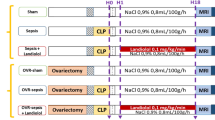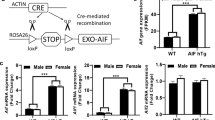Abstract
Brain death (BD) affects organs by multiple mechanisms related to hemodynamic effects, hormonal changes, and the systemic inflammatory response, which reduce organ function and viability. BD reduces microcirculatory perfusion in rat mesentery; this disturbance is also observed in the pancreas and lungs. Sex hormones can affect microcirculatory function, altering tissue perfusion and influencing the inflammatory process. Here, we present differences between sexes in the microcirculatory alterations generated by BD and in inflammatory infiltrate. Male, female, and ovariectomized-female Wistar rats were submitted to BD by intracranial balloon catheter sudden inflation. BD was confirmed by maximally dilated and fixed pupils, apnea, absence of reflexes, and a drop in mean arterial pressure. Perfusion and flow of the mesenteric microcirculation were analyzed. Intestinal myeloperoxidase activity and leukocyte infiltration were quantified. ELISA quantified serum estradiol, corticosterone, and inflammatory mediators, whereas expression of eNOS, endothelin, and endothelial adhesion molecule was measured by immunohistochemistry. Male rats presented lower percentages of mesenteric perfused microvessels and reduced blood flow compared to females. The female group presented higher eNOS and endothelin expression. Leukocyte infiltration into intestinal walls was higher in females in comparison to that in males. Moreover, the female group showed higher mesenteric vessel ICAM-1 expression than males, whereas serum TNF-α, IL-1β, and IL-10 levels did not differ between sexes. The high estradiol concentration before BD and high eNOS expression apparently favored the maintenance of microvascular perfusion/flow; however, BD caused an acute reduction of female sex hormone concentration and higher ICAM-1 level; thus, the proinflammatory organ status after BD is favored.







Similar content being viewed by others
References
Mazzuca, M.Q., K.M. Mata, W. Li, S.S. Rangan, and R.A. Khalil. 2015. Estrogen receptor subtypes mediate distinct microvascular dilation and reduction in [Ca2+]I in mesenteric microvessels of female rat. The Journal of Pharmacology and Experimental Therapeutics 352: 291–304.
Takada, M., K.C. Nadeau, W.W. Hancock, H.S. Mackenzie, G.D. Shaw, A.M. Waaga, A. Chandraker, M.H. Sayegh, and N.L. Tilney. 1998. Effects of explosive brain death on cytokine activation of peripheral organs in the rat. Transplantation 65: 1533–1542.
Novitzsky, D. 1997. Detrimental effects of brain death on the potential organ donor. Transplantation Proceedings 29: 3770–3772.
Tang, H., J. Zhang, S. Cao, B. Yan, H. Fang, H. Zhang, W. Guo, and S. Zhang. 2017. Inhibition of endoplasmic reticulum stress alleviates lung injury induced by brain death. Inflammation 40 (5): 1664–1671.
Simas, R., P. Sannomiya, J.W. Cruz, J. Correia Cde, F.L. Zanoni, M. Kase, L. Menegat, I.A. Silva, and L.F. Moreira. 2012. Paradoxical effects of brain death and associated trauma on rat mesenteric microcirculation: an intravital microscopic study. Clinics (São Paulo, Brazil) 67: 69–75.
Simas, R., S.G. Ferreira, L. Menegat, F.L. Zanoni, C.J. Correia, I.A. Silva, P. Sannomiya, and L.F. Moreira. 2015. Mesenteric hypoperfusion and inflammation induced by brain death are not affected by inhibition of the autonomic storm in rats. Clinics (São Paulo, Brazil) 70: 446–452.
Oberhuber, R., P. Ritschl, C. Fabritius, A.V. Nguyen, M. Hermann, P. Obrist, E.R. Werner, M. Maglione, B. Flörchinger, S. Ebner, T. Resch, J. Pratschke, and K. Kotsch. 2015. Treatment with tetrahydrobiopterin overcomes brain death-associated injury in a murine model of pancreas transplantation. American Journal of Transplantation 15: 2865–2876.
Breithaupt-Faloppa, A.C., S.G. Ferreira, G.K. Kudo, Armstrong R. Jr, W. Tavares-de-Lima, L.F. da Silva, P. Sannomiya, and L.F. Moreira. 2016. Sex-related differences in lung inflammation after brain death. The Journal of Surgical Research 200: 714–721.
Kuebler, J.F., D. Jarrar, B. Toth, K.I. Bland, L. Rue III, P. Wang, and I.H. Chaudry. 2002. Estradiol administration improves splanchnic perfusion following trauma-hemorrhage and sepsis. Archives of Surgery 137: 74–92.
Arnal, J.F., C. Fontaine, A. Billon-Galés, J. Favre, H. Laurell, F. Lenfant, and P. Gourdy. 2010. Estrogen receptors and endothelium. Arteriosclerosis, Thrombosis, and Vascular Biology 30: 1506–1512.
Sharawy, N., S. Ribback, N. Al-Banna, C. Lehmann, H. Kern, M. Wendt, V. Cerny, F. Dombrowski, and D. Pavlovic. 2013. Estradiol receptors agonists induced effects in rat intestinal microcirculation during sepsis. Microvascular Research 85: 118–127.
Goldblum, S.E., K.M. Wu, and M. Jay. 1985. Lung myeloperoxidase as a measure of pulmonary leukostasis in rabbits. Journal of Applied Physiology 59: 1978–1985.
Yu, H.P., Y.C. Hsieh, T. Suzuki, M.A. Choudhry, M.G. Schwacha, K.I. Bland, and I.H. Chaudry. 2007. The PI3K/Akt pathway mediates the nongenomic cardioprotective effects of estrogen following trauma-hemorrhage. Annals of Surgery 245: 971–977.
Deitch, E.A., H. Chu, and D.Z. Xu. 2008. Organ blood flow and the central hemodynamic response are better preserved in female, as opposed to the male rats, after trauma-hemorrhagic shock. The Journal of Trauma 65: 566–572.
Capone, C., J. Anrather, T.A. Milner, and C. Iadecola. 2009. Estrous cycle-dependent neurovascular dysfunction induced by angiotensin II in the mouse neocortex. Hypertension 54: 302–307.
Sandoo, A., J.J. van Zanten, G.S. Metsios, D. Carroll, and G.D. Kitas. 2010. The endothelium and its role in regulating vascular tone. Open Cardiovascular Medicine Journal 4: 302–312.
Orshal, J.M., and R.A. Khalil. 2004. Gender, sex hormones, and vascular tone. American Journal of Physiology. Regulatory, Integrative and Comparative Physiology 286: R233–R249.
Yokoyama, Y., M.G. Schwacha, K.I. Bland, and I.H. Chaudry. 2003. Effect of estradiol administration on splanchnic perfusion after trauma-hemorrhage and sepsis. Current Opinion in Critical Care 9: 137–142.
Wu, K.K. 2002. Regulation of endothelial nitric oxide synthase activity and gene expression. Annals of the New York Academy of Sciences 962: 122–130.
Laughlin, M.H., W.V. Welshons, M. Sturek, J.W. Rush, J.R. Turk, J.A. Taylor, B.M. Judy, K.K. Henderson, and V.K. Ganjam. 2003. Gender, exercise training, and eNOS expression in porcine skeletal muscle arteries. Journal of Applied Physiology 95: 250–264.
Resta, T.C., N.L. Kanagy, and B.R. Walker. 2001. Estradiol-induced attenuation of pulmonary hypertension is not associated with altered eNOS expression. American Journal of Physiology. Lung Cellular and Molecular Physiology 280: L88–L97.
Kleinert, H., T. Wallerath, C. Euchenhofer, I. Ihrig-Biedert, H. Li, and U. Förstermann. 1998. Estrogens increase transcription of the human endothelial NO synthase gene: analysis of the transcription factors involved. Hypertension 31: 582–588.
Ba, Z.F., A. Lu, T. Shimizu, L. Szalay, M.G. Schwacha, L.W. Rue 3rd, K.I. Bland, and I.H. Chaudry. 2007. 17beta-Estradiol modulates vasoconstriction induced by endothelin-1 following trauma-hemorrhage. American Journal of Physiology. Heart and Circulatory Physiology 292: H245–H250.
Dubey, R.K., E.K. Jackson, P.J. Keller, B. Imthurn, and M. Rosselli. 2001. Estradiol metabolites inhibit endothelin synthesis by an estrogen receptor-independent mechanism. Hypertension 37: 640–644.
Akishita, M., Y. Ouchi, H. Miyoshi, A. Orimo, K. Kozaki, M. Eto, M. Ishikawa, S. Kim, K. Toba, and H. Orimo. 1996. Estrogen inhibits endothelin-1 production and c-fos gene expression in rat aorta. Atherosclerosis 125: 27–38.
Keltai, K., H. Vágó, A. Zsáry, I. Karádi, V. Kékesi, A. Juhász-Nagy, and B. Merkely. 2004. Endothelin gene expression during ischemia and reperfusion. Journal of Cardiovascular Pharmacology 44: S198–S201.
Kowalczyk, A., P. Kleniewska, M. Kolodziejczyk, B. Skibska, and A. Goraca. 2015. The role of endothelin-1 and endothelin receptor antagonists in inflammatory response and sepsis. Archivum Immunologiae et Therapiae Experimentalis (Warsz) 63: 41–52.
Kolaczkowska, E., and P. Kubes. 2013. Neutrophil recruitment and function in health and inflammation. Nature Reviews. Immunology 13: 159–175.
Funding
This study was supported by the Fundação de Amparo à Pesquisa do Estado de São Paulo (grant no. 2013/20282-0). Luiz Felipe Pinho Moreira is a fellow researcher of the CNPq.
Author information
Authors and Affiliations
Contributions
SGF and ACB-F performed all experiments in collaboration with GKK, RAJr, and CJC. STR conducted the gene expression analysis. ACB–F drafted the manuscript and was advised by PS and LFPM. All authors read and approved the final manuscript.
Corresponding author
Rights and permissions
About this article
Cite this article
Ferreira, S.G., Armstrong-Jr, R., Kudo, G.K. et al. Differential Effects of Brain Death on Rat Microcirculation and Intestinal Inflammation: Female Versus Male. Inflammation 41, 1488–1497 (2018). https://doi.org/10.1007/s10753-018-0794-7
Published:
Issue Date:
DOI: https://doi.org/10.1007/s10753-018-0794-7




